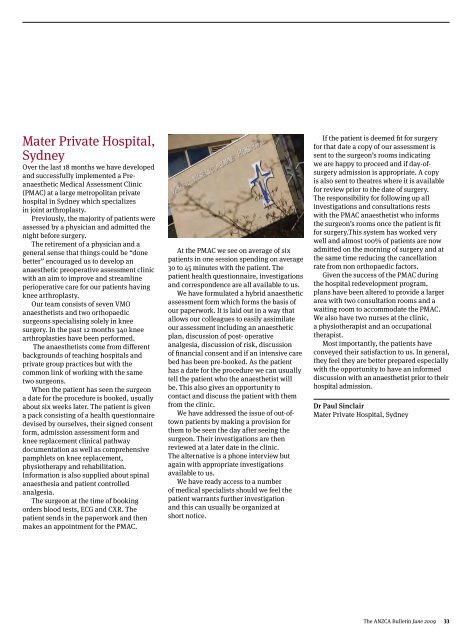ANZCA Bulletin - June 2009 - Australian and New Zealand College ...
ANZCA Bulletin - June 2009 - Australian and New Zealand College ...
ANZCA Bulletin - June 2009 - Australian and New Zealand College ...
- No tags were found...
You also want an ePaper? Increase the reach of your titles
YUMPU automatically turns print PDFs into web optimized ePapers that Google loves.
Mater Private Hospital,SydneyOver the last 18 months we have developed<strong>and</strong> successfully implemented a PreanaestheticMedical Assessment Clinic(PMAC) at a large metropolitan privatehospital in Sydney which specializesin joint arthroplasty.Previously, the majority of patients wereassessed by a physician <strong>and</strong> admitted thenight before surgery.The retirement of a physician <strong>and</strong> ageneral sense that things could be “donebetter” encouraged us to develop ananaesthetic preoperative assessment clinicwith an aim to improve <strong>and</strong> streamlineperioperative care for our patients havingknee arthroplasty.Our team consists of seven VMOanaesthetists <strong>and</strong> two orthopaedicsurgeons specialising solely in kneesurgery. In the past 12 months 340 kneearthroplasties have been performed.The anaesthetists come from differentbackgrounds of teaching hospitals <strong>and</strong>private group practices but with thecommon link of working with the sametwo surgeons.When the patient has seen the surgeona date for the procedure is booked, usuallyabout six weeks later. The patient is givena pack consisting of a health questionnairedevised by ourselves, their signed consentform, admission assessment form <strong>and</strong>knee replacement clinical pathwaydocumentation as well as comprehensivepamphlets on knee replacement,physiotherapy <strong>and</strong> rehabilitation.Information is also supplied about spinalanaesthesia <strong>and</strong> patient controlledanalgesia.The surgeon at the time of bookingorders blood tests, ECG <strong>and</strong> CXR. Thepatient sends in the paperwork <strong>and</strong> thenmakes an appointment for the PMAC.At the PMAC we see on average of sixpatients in one session spending on average30 to 45 minutes with the patient. Thepatient health questionnaire, investigations<strong>and</strong> correspondence are all available to us.We have formulated a hybrid anaestheticassessment form which forms the basis ofour paperwork. It is laid out in a way thatallows our colleagues to easily assimilateour assessment including an anaestheticplan, discussion of post- operativeanalgesia, discussion of risk, discussionof financial consent <strong>and</strong> if an intensive carebed has been pre-booked. As the patienthas a date for the procedure we can usuallytell the patient who the anaesthetist willbe. This also gives an opportunity tocontact <strong>and</strong> discuss the patient with themfrom the clinic.We have addressed the issue of out-oftownpatients by making a provision forthem to be seen the day after seeing thesurgeon. Their investigations are thenreviewed at a later date in the clinic.The alternative is a phone interview butagain with appropriate investigationsavailable to us.We have ready access to a numberof medical specialists should we feel thepatient warrants further investigation<strong>and</strong> this can usually be organized atshort notice.If the patient is deemed fit for surgeryfor that date a copy of our assessment issent to the surgeon’s rooms indicatingwe are happy to proceed <strong>and</strong> if day-ofsurgeryadmission is appropriate. A copyis also sent to theatres where it is availablefor review prior to the date of surgery.The responsibility for following up allinvestigations <strong>and</strong> consultations restswith the PMAC anaesthetist who informsthe surgeon’s rooms once the patient is fitfor surgery.This system has worked verywell <strong>and</strong> almost 100% of patients are nowadmitted on the morning of surgery <strong>and</strong> atthe same time reducing the cancellationrate from non orthopaedic factors.Given the success of the PMAC duringthe hospital redevelopment program,plans have been altered to provide a largerarea with two consultation rooms <strong>and</strong> awaiting room to accommodate the PMAC.We also have two nurses at the clinic,a physiotherapist <strong>and</strong> an occupationaltherapist.Most importantly, the patients haveconveyed their satisfaction to us. In general,they feel they are better prepared especiallywith the opportunity to have an informeddiscussion with an anaesthetist prior to theirhospital admission.Dr Paul SinclairMater Private Hospital, SydneyThe <strong>ANZCA</strong> <strong>Bulletin</strong> <strong>June</strong> <strong>2009</strong> 33
















